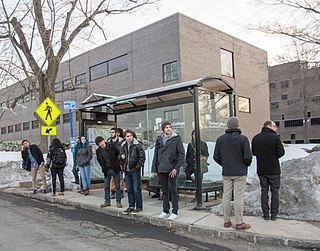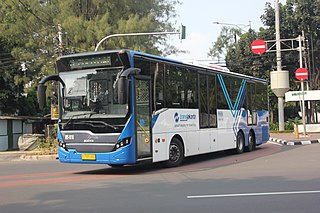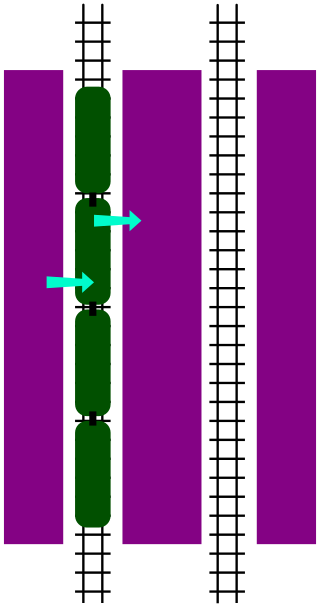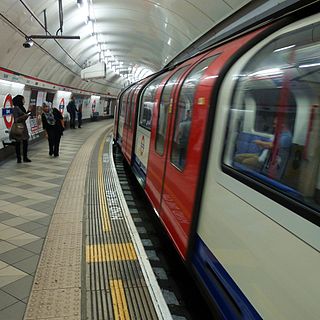
Personal rapid transit (PRT), also referred to as podcars or guided/railed taxis, is a public transport mode featuring a network of specially built guideways on which ride small automated vehicles that carry few passengers per vehicle. PRT is a type of automated guideway transit (AGT), a class of system which also includes larger vehicles all the way to small subway systems. In terms of routing, it tends towards personal public transport systems.

A conductor or guard is a train crew member responsible for operational and safety duties that do not involve actual operation of the train/locomotive. The conductor title is most common in North American railway operations, but the role is common worldwide under various job titles. In Commonwealth English, a conductor is also known as guard or train manager.

A bus stop is a place where buses stop for passengers to get on and off the bus. The construction of bus stops tends to reflect the level of usage, where stops at busy locations may have shelters, seating, and possibly electronic passenger information systems; less busy stops may use a simple pole and flag to mark the location. Bus stops are, in some locations, clustered together into transport hubs allowing interchange between routes from nearby stops and with other public transport modes to maximise convenience.

A tram stop, tram station, streetcar stop, or light rail station is a place designated for a tram, streetcar, or light rail vehicle to stop so passengers can board or alight it. Generally, tram stops share most characteristics of bus stops, but because trams operate on rails, they often include railway platforms, especially if stepless entries are provided for accessibility. However, trams may also be used with bus stop type flags and with mid-street pavements as platforms, in street running mode.

Bus rapid transit (BRT), also referred to as a busway or transitway, is a trolleybus, electric bus and public transport bus service system designed to have much more capacity, reliability, and other quality features than a conventional bus system. Typically, a BRT system includes roadways that are dedicated to buses, and gives priority to buses at intersections where buses may interact with other traffic; alongside design features to reduce delays caused by passengers boarding or leaving buses, or paying fares. BRT aims to combine the capacity and speed of a light rail transit (LRT) or mass rapid transit (MRT) system with the flexibility, lower cost and simplicity of a bus system.

Proof-of-payment(POP) or proof-of-fare(POF) is an honor-based fare collection system used on many public transportation systems. Instead of checking each passenger as they enter a fare control zone, passengers are required to carry a paper ticket, transit pass, transit smartcard — or open payment methods such as contactless credit or debit cards (if applicable) — after swiping or tapping on smart card readers, to prove that they have paid the valid fare. Fares are enforced via random spot-checks by inspectors such as conductors or enforcement officers, to ensure that passengers have paid their fares and are not committing fare evasion. On many systems, a passenger can purchase a single-use ticket or multi-use pass at any time in advance, but must insert the ticket or pass into a validation machine immediately before use. Validation machines in stations or on board vehicles time stamp the ticket. The ticket is then valid for some period of time after the stamped time.

The Baltimore Light RailLink is a light rail system serving Baltimore, Maryland, United States, and its northern and southern suburbs. It is operated by the Maryland Transit Administration. In downtown Baltimore, it uses city streets. Outside the central portions of the city, the line is built on private rights-of-way, mostly from the defunct Northern Central Railway, Baltimore and Annapolis Railroad and Washington, Baltimore and Annapolis Electric Railway. The system had a ridership of 3,546,300, or about 15,400 per weekday, as of the third quarter of 2024.

Traveston railway station is located on the North Coast line in Queensland, Australia. It serves the town of Traveston.

In public transport, a request stop, flag stop, or whistle stop is a stop or station at which buses or trains, respectively, stop only on request; that is, only if there are passengers or freight to be picked up or dropped off. In this way, stops with low passenger counts can be incorporated into a route without introducing unnecessary delay. Vehicles may also save fuel by continuing through a station when there is no need to stop.

Gap fillers close the gap between platform and train cars in the area of doors. This prevents alighting passengers from accidentally getting stuck in the gap. There are train-mounted gap fillers, whereas platform gap fillers are movable platform edge extensions installed at subway or railway stations. Gap fillers are deployed once the train stops but before doors open, and retracted after doors are closed and before the train departs.
Headway is the distance or duration between vehicles in a transit system measured in space or time. The minimum headway is the shortest such distance or time achievable by a system without a reduction in the speed of vehicles. The precise definition varies depending on the application, but it is most commonly measured as the distance from the tip of one vehicle to the tip of the next one behind it. It can be expressed as the distance between vehicles, or as time it will take for the trailing vehicle to cover that distance. A "shorter" headway signifies closer spacing between the vehicles. Airplanes operate with headways measured in hours or days, freight trains and commuter rail systems might have headways measured in parts of an hour, metro and light rail systems operate with headways on the order of 90 seconds to 20 minutes, and vehicles on a freeway can have as little as 2 seconds headway between them.
Boarding is the entry of passengers onto a vehicle, usually in public transportation. Boarding starts with entering the vehicle and ends with the seating of each passenger and closing the doors. The term is used in road, rail, water and air transport.

In railway and rapid transit parlance, the Spanish solution is a station layout with two railway platforms, one on each side of the track, which allows for separate platforms for boarding and alighting.

Taraval and 40th Avenue is a light rail stop on the Muni Metro L Taraval line, located in the Parkside neighborhood of San Francisco, California, United States. The station opened with the second section of the L Taraval line on January 14, 1923.

A train station, railroad station, or railroad depot and railway station is a railway facility where trains stop to load or unload passengers, freight, or both. It generally consists of at least one platform, one track, and a station building providing such ancillary services as ticket sales, waiting rooms, and baggage/freight service. Stations on a single-track line often have a passing loop to accommodate trains travelling in the opposite direction.

High-floor describes the interior flooring of commuter vehicles primarily used in public transport such as trains, light rail cars and other rail vehicles, along with buses and trolleybuses. Interior floor height is generally measured above the street surface or above the top of the rail. High-floor designs usually result from packaging requirements: mechanical items such as axles, motors, crankshafts, and/or transmissions, or luggage storage spaces are traditionally placed under the interior floor of these vehicles. The term is used in contrast with low-floor designs, which offer a decreased floor and entry height above the street surface. Since low-floor designs generally were developed after high-floor vehicles, the older high-floor design is sometimes also known as conventional or the “traditional” design.

A platform gap is the space between a train car and the edge of the station platform, often created by geometric constraints, historic legacies, or use of partially compatible equipment.

A crush load is a level of passenger loading in a transport vehicle which is so high that passengers are "crushed" against one another. It represents an extreme form of passenger loading, and normally considered to be representative of a system with serious capacity limitations. Crush loads result from too many passengers within a vehicle designed for a much smaller number. Crush loaded trains or buses are so heavily loaded that for most passengers physical contact with several other nearby passengers is impossible to avoid.

Route capacity is the maximum number of vehicles, people, or amount of freight than can travel a given route in a given amount of time, usually an hour. It may be limited by the worst bottleneck in the system, such as a stretch of road with fewer lanes. Air traffic route capacity is affected by weather. For a metro or a light rail system, route capacity is generally the capacity of each vehicle, times the number of vehicles per train, times the number of trains per hour (tph). In this way, route capacity is highly dependent on headway. Beyond this mathematical theory, capacity may be influenced by other factors such as slow zones, single-tracked areas, and infrastructure limitations, e.g. to useful train lengths.

Peoria station, also known as Peoria/Smith station, is a Regional Transportation District (RTD) station in Aurora, Colorado. The station is served by the A Line, a commuter rail line from Union Station in Downtown Denver to Denver International Airport, and the R Line, a light rail line crossing through Aurora and South to Lone Tree. A Line travel times from the station to Downtown Denver and Denver International Airport are about 17 and 20 minutes, respectively. Peoria station is the northern terminus of the R Line with a travel time of 58 minutes to the southern terminus at Lincoln station.


















